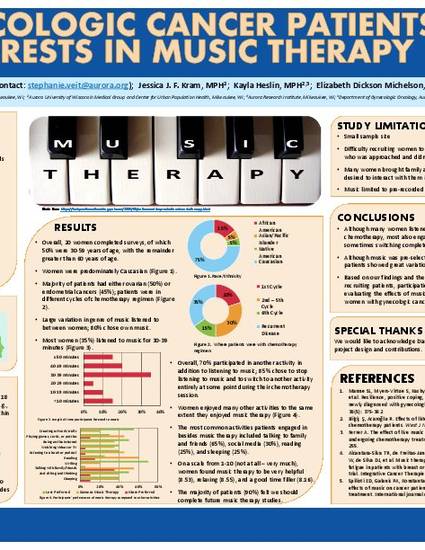
Background: Music therapy has been used as complementary therapy in oncology patients undergoing chemotherapy for decades. Several studies have suggested potential benefits associated with music therapy use, including alleviation of mood symptoms like anxiety and other common chemotherapy side effects like nausea and vomiting. Although case reports have reported music therapy use among women with gynecologic cancers, no formal studies have been conducted.
Purpose: To evaluate patients’ thoughts on music therapy as an adjunct to chemotherapy and to evaluate patients’ use of music therapy in comparison to other media types.
Methods: We conducted a feasibility study that prospectively surveyed adult women undergoing chemotherapy for a gynecologic cancer (endometrial cancer, ovarian cancer, cervical cancer, etc) within 1 hospital center from June 2018 to July 2019. Women were asked demographic and preliminary questions prior to being provided preselected music on an audio listening device. Following their chemotherapy session, women were asked to complete a survey remarking on their thoughts about music therapy and use of other media. Basic descriptive statistics were conducted.
Results: Overall, 20 women completed surveys, of which 50% were 30–59 years of age, with the remainder greater than 60 years of age. Women were predominately Caucasian (75%) and mostly had either ovarian (50%) or endometrial (45%) cancer. Overall, 80% of women chose to listen to the music provided instead of their own music. Most women (35%) listened to music for 30–39 minutes during their chemotherapy session. Choice of music genre varied greatly between women. Ultimately, 70% of women participated in another activity in addition to listening to music, with 85% choosing to switch to another activity entirely at some point during their chemotherapy session. The most common activities patients engaged in besides music therapy included talking to family and friends (65%), social media (30%), reading (25%), and sleeping (25%). Women found music therapy to be very helpful, relaxing, and a good time-filler.
Conclusion: Although many women listened to music during their chemotherapy, most also engaged in another activity, sometimes switching completely to that other activity. Based on our findings and the difficulties of even surveying patients, participation in a larger study aimed at evaluating effects of music therapy on chemotherapy in women with gynecologic cancers may be quite difficult.
Veit S, Kram JJF, Heslin K, Dickson Michelson E. Gynecologic cancer patients’ interests in music therapy. Poster presented at: Aurora Scientific Day; May 20, 2020; virtual webinar hosted in Milwaukee, WI.

Department of Obstetrics and Gynecology
Aurora Sinai Medical Center
Aurora University of Wisconsin Medical Group and Center for Urban Population Health
Aurora Research Institute
Department of Gynecologic Oncology, Aurora West Allis Medical Center